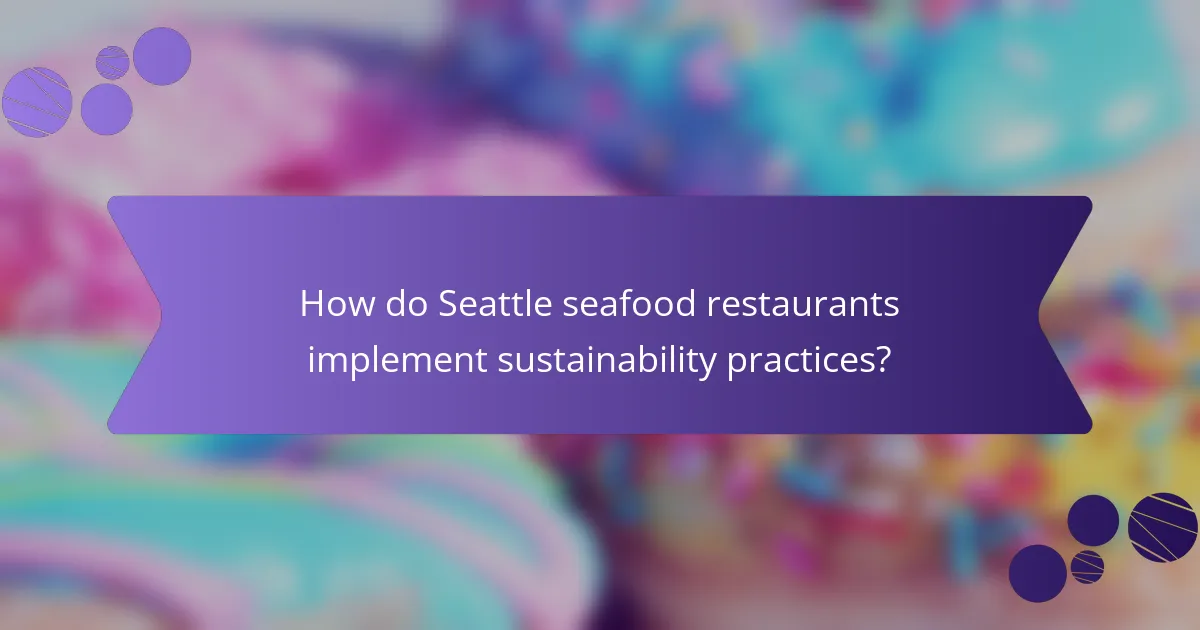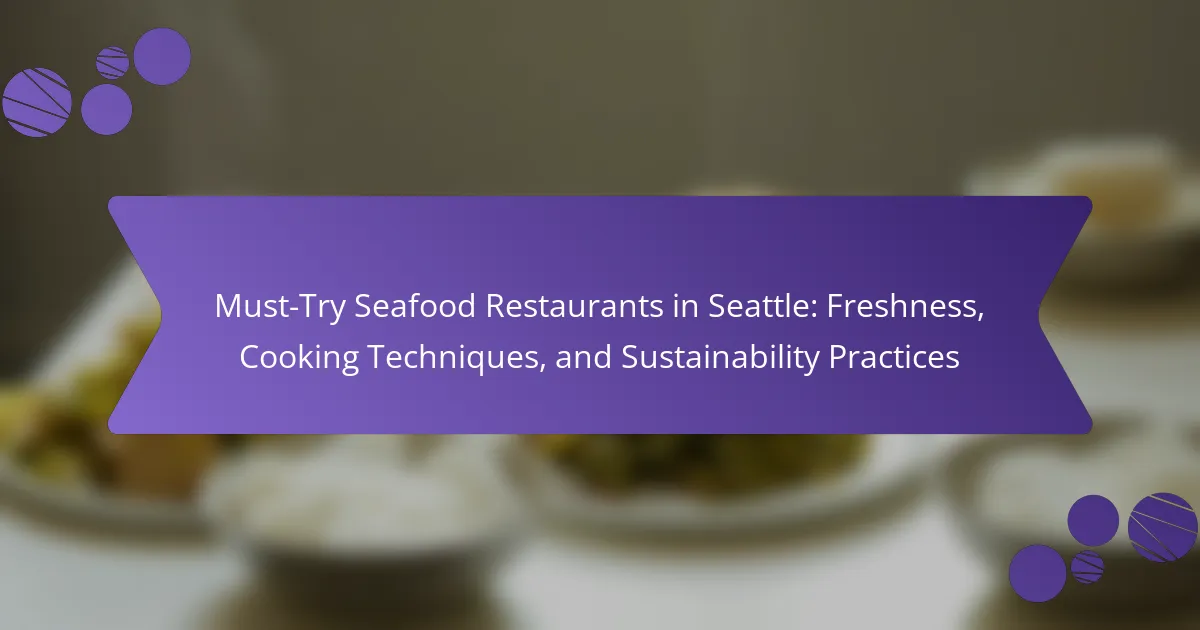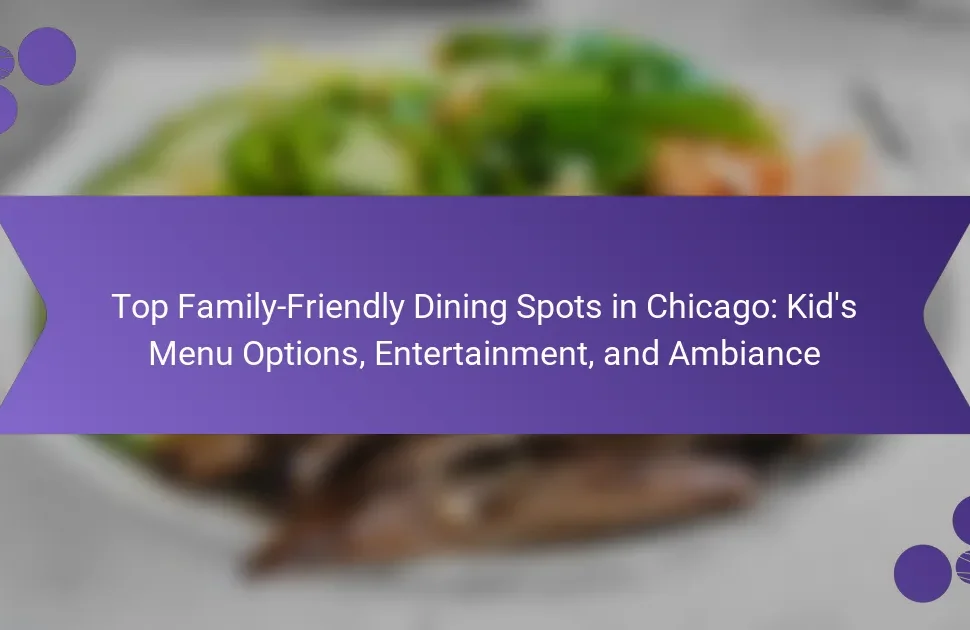
What are the Must-Try Seafood Restaurants in Seattle?
The must-try seafood restaurants in Seattle include The Walrus and the Carpenter, Canlis, and Pike Place Chowder. The Walrus and the Carpenter is famous for its oysters and small plates. Canlis offers a fine dining experience with a focus on fresh seafood. Pike Place Chowder is renowned for its award-winning clam chowder. These restaurants emphasize local sourcing and sustainability. Seattle’s seafood scene is recognized for its quality and variety. Each restaurant showcases unique cooking techniques and flavors.
Why is Seattle known for its seafood restaurants?
Seattle is known for its seafood restaurants due to its proximity to the Pacific Ocean and rich marine resources. The city’s location allows easy access to fresh fish and shellfish. Local seafood includes salmon, halibut, crab, and shellfish like clams and oysters. The fishing industry in Washington State is robust, contributing to the availability of high-quality seafood. Seattle’s culinary scene emphasizes sustainability and responsible sourcing. Many restaurants feature seafood caught within a day or two of serving. The city’s culture celebrates seafood through iconic dishes and local markets like Pike Place Market. These factors collectively establish Seattle as a premier destination for seafood dining.
What geographical factors contribute to Seattle’s seafood offerings?
Seattle’s seafood offerings are significantly influenced by its geographical location. The city is situated on the Puget Sound, which provides access to rich marine ecosystems. These ecosystems support diverse fish populations, including salmon, halibut, and shellfish. The surrounding coastal waters are nutrient-rich due to upwelling currents. This natural phenomenon enhances fish abundance, making Seattle a prime location for seafood harvesting. Additionally, Seattle’s proximity to the Pacific Ocean facilitates access to a wider variety of seafood. The region’s mild climate also supports sustainable fishing practices. This combination of factors ensures that Seattle’s seafood remains fresh and diverse, appealing to both locals and visitors.
How does the local culture influence seafood dining in Seattle?
Local culture significantly influences seafood dining in Seattle. The city’s proximity to the Pacific Ocean ensures access to fresh seafood. This availability shapes local culinary traditions and preferences. Seattle’s culture emphasizes sustainability and environmental responsibility. Many restaurants prioritize sourcing seafood from sustainable fisheries. Additionally, local festivals celebrate seafood, such as the Seattle Seafood Festival. These events promote community engagement and appreciation for local cuisine. The diverse population also introduces various cooking techniques and flavors. This cultural blend enriches the seafood dining experience in Seattle.
What defines the freshness of seafood in Seattle restaurants?
The freshness of seafood in Seattle restaurants is defined by its sourcing, storage, and preparation methods. Seafood is considered fresh when it is caught and delivered to restaurants within 24 hours. Local fisheries and sustainable fishing practices contribute to this rapid supply chain. Proper refrigeration during transport maintains the seafood’s quality. Restaurants often display catch-of-the-day specials, highlighting recently sourced seafood. Additionally, sensory indicators such as smell, texture, and appearance are crucial. Fresh seafood should have a mild ocean scent, firm texture, and bright coloration. These factors ensure that diners experience high-quality seafood that reflects Seattle’s coastal environment.
How do Seattle restaurants ensure the seafood they serve is fresh?
Seattle restaurants ensure the seafood they serve is fresh by sourcing from local fisheries and markets. They often purchase seafood directly from fishermen who follow sustainable practices. Many restaurants have established relationships with suppliers to guarantee quality and freshness. Some use ice-packed shipping methods to maintain temperature during transport. Additionally, restaurants frequently check the seafood for signs of freshness, such as smell and appearance. Local regulations require seafood to meet specific freshness standards. Many establishments also display the catch date on their menus to inform customers. This commitment to freshness supports both quality dining experiences and local economies.
What role does the supply chain play in seafood freshness?
The supply chain plays a critical role in maintaining seafood freshness. It involves the processes of sourcing, transporting, and storing seafood from catch to consumer. Efficient supply chain management minimizes the time seafood spends outside of controlled environments. Temperature control is essential throughout the supply chain to prevent spoilage.
Rapid transportation methods help deliver seafood quickly to restaurants. Packaging also plays a role, as it protects seafood from contamination and preserves quality. Traceability within the supply chain ensures that seafood is sourced sustainably, impacting its overall freshness. Research indicates that seafood loses quality rapidly without proper supply chain practices. According to the Seafood Source, seafood can begin to spoil within hours if not handled correctly.
What cooking techniques are popular in Seattle’s seafood restaurants?
Popular cooking techniques in Seattle’s seafood restaurants include grilling, steaming, and poaching. Grilling enhances the natural flavors of fish and shellfish. Steaming preserves moisture and nutrients in seafood. Poaching is a gentle method that maintains tenderness. These techniques align with the region’s emphasis on freshness. Seattle’s proximity to the Pacific Ocean ensures access to high-quality seafood. Many chefs also incorporate local ingredients to complement these cooking methods. This approach highlights the culinary diversity in the area.
How does grilling enhance the flavor of seafood dishes?
Grilling enhances the flavor of seafood dishes by imparting a smoky taste and creating a caramelized crust. The high heat from grilling causes the Maillard reaction, which develops complex flavors. This technique also helps retain the seafood’s natural moisture, preventing it from drying out. Grilling allows for the infusion of marinades and seasonings, intensifying the overall taste. Additionally, the charred exterior adds a depth of flavor that complements the delicate nature of seafood. Research shows that grilling seafood can elevate its taste profile significantly compared to other cooking methods.
What are the benefits of steaming seafood compared to frying?
Steaming seafood offers several benefits compared to frying. Steaming preserves the natural moisture and nutrients of seafood. This cooking method reduces the loss of vitamins and minerals, making the dish healthier. In contrast, frying often leads to the absorption of excess oil, increasing calorie content. Steamed seafood typically contains fewer unhealthy fats. Additionally, steaming allows for the use of herbs and spices without adding calories. This enhances flavor without compromising health. Studies show that steaming can reduce the formation of harmful compounds associated with high-temperature cooking methods. Overall, steaming is a healthier, nutrient-preserving option for seafood preparation.

How do Seattle seafood restaurants implement sustainability practices?
Seattle seafood restaurants implement sustainability practices by sourcing seafood from certified sustainable fisheries. They prioritize local and seasonal ingredients to minimize environmental impact. Many restaurants participate in programs like the Marine Stewardship Council certification. They also reduce waste through composting and recycling initiatives. Some establishments offer plant-based alternatives to lessen reliance on seafood. Additionally, they engage in community education on sustainable practices. These efforts contribute to the overall health of marine ecosystems and support local economies.
Why is sustainability important in seafood sourcing?
Sustainability is crucial in seafood sourcing to ensure the long-term health of marine ecosystems. Overfishing threatens fish populations and disrupts aquatic food chains. Sustainable practices help maintain biodiversity and protect habitats. According to the Food and Agriculture Organization, about 34% of global fish stocks are overfished. Sustainable sourcing also supports local economies by promoting responsible fishing practices. These practices can lead to better quality seafood for consumers. Sustainable seafood is often fresher and more nutritious. Choosing sustainably sourced seafood contributes to environmental conservation and responsible consumption.
What certifications should consumers look for in sustainable seafood?
Consumers should look for certifications like the Marine Stewardship Council (MSC) and the Aquaculture Stewardship Council (ASC) when choosing sustainable seafood. The MSC certification indicates that wild-caught seafood comes from fisheries that are sustainably managed. This organization assesses fisheries against strict sustainability criteria. The ASC certification signifies that farmed seafood is produced responsibly, minimizing environmental impact. It ensures adherence to social and environmental standards. Other notable certifications include the Global Aquaculture Alliance’s Best Aquaculture Practices (BAP) and the Seafood Watch recommendations. These certifications help consumers make informed choices regarding sustainable seafood options.
How do local regulations support sustainable fishing practices?
Local regulations support sustainable fishing practices by establishing quotas and size limits. These rules prevent overfishing and allow fish populations to recover. Regulations also restrict fishing methods that harm the ecosystem. For example, bans on certain nets reduce bycatch. Licensing requirements ensure that only qualified fishers operate. Many regions mandate reporting of catches to monitor fish stocks. Compliance with these regulations is enforced through inspections and penalties. Studies show that regions with strict regulations see healthier fish populations and more sustainable fisheries.
What are some examples of sustainable seafood practices in Seattle restaurants?
Seattle restaurants implement several sustainable seafood practices. Many source seafood from certified sustainable fisheries. For example, some establishments use the Marine Stewardship Council (MSC) certification. Others prioritize local seafood to reduce transportation emissions. Additionally, restaurants often highlight seasonal seafood options. They may also avoid overfished species. Some restaurants participate in community-supported fisheries (CSFs). These practices ensure a more responsible seafood supply chain. Overall, Seattle’s dining scene emphasizes sustainability in seafood sourcing.
How do restaurants engage in responsible sourcing?
Restaurants engage in responsible sourcing by selecting ingredients that are sustainably produced. They prioritize local and seasonal products to reduce carbon footprints. Many restaurants collaborate with certified suppliers who adhere to ethical practices. This includes sourcing seafood from fisheries that follow sustainable fishing guidelines. Additionally, they often participate in farm-to-table initiatives, ensuring freshness and supporting local economies. Restaurants may also avoid ingredients linked to environmental degradation. Transparency in sourcing practices helps build trust with customers. According to the Marine Stewardship Council, responsible sourcing can lead to healthier oceans and ecosystems.
What initiatives are in place to reduce food waste in seafood dining?
Restaurants in seafood dining implement various initiatives to reduce food waste. Many establishments practice portion control to minimize leftover food. They often utilize the entire seafood product, including less popular cuts and by-products. Some restaurants collaborate with local food banks to donate excess seafood. Others engage in composting programs for organic waste. Technology is also employed, such as inventory management systems to track seafood freshness and reduce spoilage. Additionally, consumer education campaigns raise awareness about sustainable seafood choices. These initiatives collectively contribute to a significant reduction in food waste within the seafood dining industry.

What are the top seafood dishes to try in Seattle?
The top seafood dishes to try in Seattle include Dungeness crab, clam chowder, salmon, and oysters. Dungeness crab is known for its sweet, tender meat and is often served steamed or in crab cakes. Clam chowder, particularly the creamy version, is a staple in Seattle, highlighting the region’s abundant clams. Salmon, especially wild-caught Alaskan salmon, is celebrated for its rich flavor and is commonly grilled or smoked. Oysters from the Pacific Northwest are renowned for their briny taste and are often enjoyed raw on the half shell. These dishes reflect Seattle’s coastal culinary heritage and commitment to fresh, sustainable seafood.
What are the signature dishes at Seattle’s best seafood restaurants?
Seattle’s best seafood restaurants are known for signature dishes like Dungeness crab, clam chowder, and salmon. Dungeness crab is often served steamed or in salads. Clam chowder is a creamy soup featuring local clams and potatoes. Salmon is frequently grilled or smoked, highlighting its rich flavor. Other notable dishes include fish tacos and oyster shooters. These dishes reflect Seattle’s access to fresh, local seafood. The emphasis on sustainability enhances the dining experience. Many restaurants source their ingredients from local fisheries. This commitment to freshness and quality is a hallmark of Seattle’s seafood scene.
How do seasonal ingredients influence seafood menus?
Seasonal ingredients significantly influence seafood menus by dictating the availability and freshness of the catch. Restaurants often adjust their offerings based on what is in season to ensure optimal flavor and quality. For example, certain fish species are more abundant during specific months, impacting menu selections. Seasonal vegetables and herbs also complement seafood dishes, enhancing taste profiles. This practice supports local fishing industries and promotes sustainability. By utilizing seasonal ingredients, restaurants can provide diners with the freshest seafood experience. Additionally, it encourages chefs to innovate and create unique dishes that reflect the changing seasons.
What unique flavor combinations can be found in Seattle seafood cuisine?
Seattle seafood cuisine features unique flavor combinations such as miso and black cod. This pairing enhances the natural richness of the fish. Another popular combination is smoked salmon with cream cheese and capers. This reflects the city’s culinary traditions and local ingredients. Dungeness crab often pairs with garlic butter and lemon. This combination highlights the sweetness of the crab. Additionally, Pacific Northwest oysters are often served with a mignonette sauce. This adds a tangy contrast to the briny flavor of the oysters. These combinations showcase the region’s emphasis on fresh, high-quality seafood.
How can diners choose the best seafood restaurant in Seattle?
Diners can choose the best seafood restaurant in Seattle by considering freshness, cooking techniques, and sustainability practices. Freshness is crucial; restaurants that source seafood daily from local fisheries tend to offer the best quality. Cooking techniques also matter; establishments that use methods like grilling or steaming preserve the natural flavors of seafood. Sustainability practices are increasingly important; diners should look for restaurants that follow responsible sourcing guidelines. Reviews and ratings on platforms like Yelp or TripAdvisor can provide insights into customer experiences. Additionally, awards from local culinary organizations often highlight top seafood spots.
What factors should be considered when selecting a seafood restaurant?
Freshness of seafood is a primary factor when selecting a seafood restaurant. Fresh seafood enhances flavor and ensures safety. Look for restaurants that source their seafood daily or have a clear supply chain. Cooking techniques also matter significantly. Restaurants that use methods like grilling or steaming preserve the seafood’s natural flavors. Sustainability practices are increasingly important. Choose restaurants that prioritize eco-friendly sourcing and avoid overfished species. Reviews and ratings can provide insight into the quality and reputation of the restaurant. Location and ambiance also play a role in the dining experience. Finally, consider menu variety to ensure options for different tastes and dietary preferences.
How do online reviews and ratings impact restaurant choices?
Online reviews and ratings significantly influence restaurant choices. Consumers often rely on these reviews to gauge food quality and service. A study by BrightLocal found that 79% of consumers trust online reviews as much as personal recommendations. Positive ratings can attract new customers, while negative ones can deter them. Restaurants with high ratings typically see increased foot traffic and higher sales. Online platforms like Yelp and Google Reviews provide visibility and credibility. Customers often check multiple reviews before making a decision. The overall sentiment in reviews can shape public perception of a restaurant’s brand.
What tips can enhance the seafood dining experience in Seattle?
To enhance the seafood dining experience in Seattle, choose restaurants known for their freshness. Fresh seafood is often sourced daily from local markets. Research the restaurant’s sustainability practices to ensure responsible sourcing. Pair your meal with local wines or craft beers for a complementary taste. Consider visiting during happy hour for special deals on seafood dishes. Ask the staff for recommendations on seasonal specialties. Dining near the waterfront can provide scenic views that elevate the experience. Lastly, try to sample a variety of dishes to appreciate the diverse flavors of Pacific Northwest seafood.
Must-Try Seafood Restaurants in Seattle focus on the city’s renowned seafood dining scene, highlighting establishments like The Walrus and the Carpenter, Canlis, and Pike Place Chowder. The article explores the geographical advantages that contribute to Seattle’s seafood freshness, the cultural influences on local dining, and various cooking techniques such as grilling and steaming. It also emphasizes sustainability practices in sourcing seafood, detailing certifications and local regulations that support responsible fishing. Additionally, readers will discover signature dishes and tips for enhancing their seafood dining experience in Seattle.




